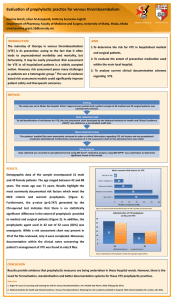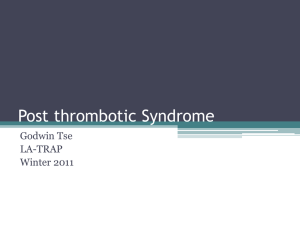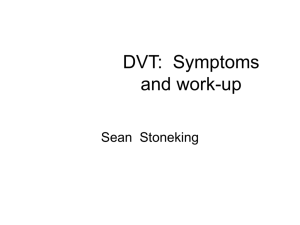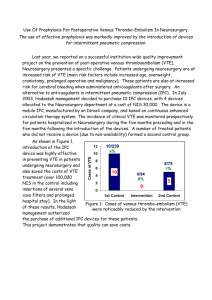Venous Thromboembolism Prophylaxis
advertisement
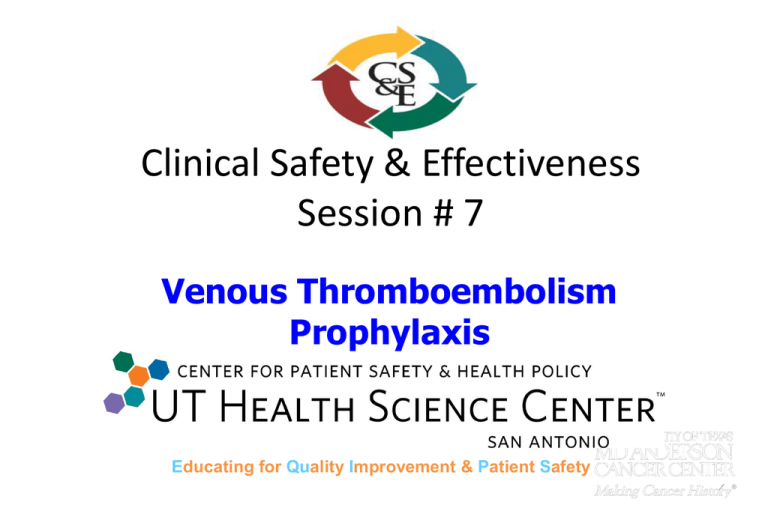
Clinical Safety & Effectiveness Session # 7 Venous Thromboembolism Prophylaxis DATE Educating for Quality Improvement & Patient Safety 1 What We Are Trying to Accomplish? OUR AIM STATEMENT The aim of this project is to increase the compliance of ordering Venous Thromboembolism Prophylaxis for at risk 9th Floor General Medicine patients at University Hospital from 76% to 95% by June 1, 2011. 2 • CS&E Participants The Team – Kevin Schindler, MD • UHS Hospitalist – Sheryl Cobb, RN MSN • Q&PI Director • Sponsor Departments – UHS, Quality & Process Improvement and Pharmacy Departments – UHS, QC and Anticoag. Safety Comm. – UTHSCA, Dept. of Medicine • Support Staff (IT) – Dr. Alton Powell • Chief Medical Information Officer – Lorri Savoie • Director, Computer Training Services • Team Members – Michael Johnson, MD • UHS Hospitalist – Crystal Franco-Martinez, PharmD • Clinical Pharmacist, Anticoagulation – Carla McDaniel RN • Sr. Analyst, Q&PI, Data Abstractor – Bonnie Jones, RN BC • RN Educator, 9th General Medicine – Elizabeth Wilson, RN BSN • Admin. Dir. , 9th General Medicine – Carol Mancinas, MHA • Sr. Analyst, Q&PI, Data Support • Facilitator – Amruta Parekh, MD MPH 3 Project Milestones • • • • • Team Created AIM statement created Weekly Team Meetings 5 Additional Team Meetings Background Data, Workflow, Fishbone, and Brainstorming • Interventions Implemented • Data Analysis – Weekly x 9wks, then Bi Weekly • CS&E Presentation Jan 21, 2011 Feb 4, 2011 Jan 28 – Mar 4, 2011 Mar 25 – May 27, 2011 Jan 24 - Mar 4, 2011 Mar 18/21 (Initial) - Ongoing Jan 24 – May 27, 2011 June 24, 2011 4 Background • VTE adopted by CMS as a Core Measure – Voluntary participation: Began 4th Qtr 2009 – Required participation: Anticipate ~Jan 2012 – Linked to Pay for Performance (P4P) – Posted publicly on the Internet w/other Core Measures • What Cases are Reviewed? – Hospitals accepting CMS “dollars” contract through a CMS approved vendor. – Cases selected by vendor and not by the facility – Based on ICD-9 and CPT coding at discharge – Each case does not always meet criteria for all measures • Meets criteria for VTE prophylaxis at admission but not at d/c 5 Core Measure Objectives • Improve Quality of Patient Care – Utilization of Best Practice – Positive Patient Outcomes – Reduce Re-Admissions – Provide Care in the most Cost Effective Manner • Information Provided Publicly on the Internet – Provide consumers with quality of care information – Provide consumers in making more informed decisions about their healthcare 6 VTE Core Measures • VTE-1 VTE Prophylaxis (focus of the project) • VTE-2 Intensive Care Unit VTE Prophylaxis • VTE-3 VTE Patients with Anticoagulation Overlap Therapy • VTE-4 VTE Patients Receiving Unfractionated Heparin with Dosages/Platelet Count Monitoring by Protocol • VTE-5 VTE Discharge Instructions • VTE-6 VTE Incidence of Potentially-Preventable VTE Note: Additionally, there are two VTE measures included in the SCIP Core Measure (Surgical Care Improvement Project) 7 Components of VTE-1 Measure • Numerator Statement Patients who received VTE prophylaxis OR have documentation why no VTE prophylaxis was given --- Medicine Patients…..by the end of day 2 from admission (Day 1 is admission date) --- Surgery Patients…..based on the correlation between the date of surgery and the admission date. • Denominator Statement All patients selected for the review 8 Included Population • Patients age 18 and over • Length of Stay –greater than 24 hours and – less than 120 days • Discharged with at least one of the eligible ICD 9 Codes Quality Net. Venous Thromboembolism National Hospital Inpatient Quality Measures. http://www.qualitynet.org/dcs/ContentServer?c=Page&pagename=QnetPublic%2FPage%2FQnetTier4&cid=1228754600169 9 Incidence of DVT/PE and Deaths Annual Surgeon General Call to Action 2008 John Heit Data (Mayo Clinic) 2005 350,000 – 600,000 100,000 900,000 300,000 27,335 - 46,860 7,810 70,290 23,430 United States Incidence of DVT/PE Deaths (Mortality) Texas (# 2 in the nation) Incidence of DVT/PE Deaths (Mortality) National Blood Clot Alliance. Stop The Clot. Deep Vein Thrombosis (DVT) Incidence Map. Website: http://www.stoptheclot.org/News/article163.htm 10 The Facts • Over one year, a 300 bed hospital that lacks a systematic approach to VTE prevention can expect roughly 150 cases of hospital-acquired VTE. • Approx. 5 of those will die from potentially preventable pulmonary embolism. • Each hospital acquired DVT represents a incremental inpatient cost of $10K, while each PE represents a $20K price tag. Preventing Hospital-Acquired Venous Thromboembolism A Guide for Effective Quality Improvement. Society of Hospital Medicine, website. Why Did We Choose This Project? UHS Overall VTE 1 Venous Thromboembolism Prophylaxis (Oct 09-Oct 10) 100% 90% 80% 70% 60% 50% 40% 30% 20% 10% Oct 10 Sep 10 Aug 10 Jul 10 Jun 10 May 10 Apr 10 Mar 10 Feb 10 Jan 10 Dec 09 Nov 09 Oct 09 0% 12 Flow Diagram Page 1 of 2 Two Opportunities to PASS the Measure 13 Flow Diagram Page 2 of 2 Five Opportunities to FAIL the Measure 14 Brainstorming Ideas • • • • • • Find out why attending and residents don’t buy-in to tool – Solicit input Education program for housestaff and attending – Multiprong approach • Conferences • E-mail • Target night float (8p-7a) • Pamphlets • 5-minute sessions • 1-on-1 for fallouts • Screen saver • Flyers In call rooms • Memo at opening of SR – on log-in screen • Let MDs know that the nurse will be calling if screen not done – Include nursing • Empower to talk to MDs • Flash ad • Include criteria for understanding and follow-up of high, medium and low risk on screening Push “Low Risk” on screening into a Sunrise location so the nurse can see it Create a Sunrise alert if screening is not done by end of Day 2 or within 12 hours of admission Add a hard stop on the admission order Incorporate into Medicine template note Establish nursing guideline for what to do if no orders – need • • • • • • • • concrete actions Charge nurse can look at admission orders to see if screening done and let MD know if needed (second look) Patient’s nurse looks at admission orders to see if screening done and calls MD if screening is not done Add question to RN assessment (or somewhere) that asks “Has DVT prophylaxis been addressed?” – If No, RN is to call MD – RN to document when called – Roll out as a pilot Nurse should write an ERAF when MD is verbally abusive (include in education) Staff should wear SCDs to visually remind MDs Buttons for staff Make this important to administration by tying to – Core measures – Money – Reassessment – Find a champion (Mary Ann Mote, Dr. Alsip, or Nancy Ray) Add as a responsibility to case managers (CM doesn’t change for patient) Most Creative Idea….. Staff should wear SCDs to visually remind the MDs 17 Achievable Ideas • Solicit Input – Why isn’t it used by attending and/or residents (Buy In?) • Education – Physician: Awareness and utilization of the tool – Nursing: Awareness of low, medium, high risk patients with recommended treatments – Other: Email, Pamphlets, Flash Ad’s, Podcast, Posters • Nursing Empowerment: contact MD, charge nurse review of admit orders • Executive Buy In: Core Measures and Reimbursement 18 Action plans • Educational program given to faculty and house staff – Focused on utilization of risk assessment tool • Educational program for nurses • Direct feedback to failures • Nurse managers empowered to call providers if no screen done • Flyers made for call rooms 19 The DVT Prophylaxis Screen Developed by Dr. Michael Johnson and Crystal Franco-Martinez Educational program • • • • • • Presentation given to Hospitalist group Presentation given to Internal Medicine Residents Distribution of educational handouts Emails sent to faculty and house staff Feedback given directly to physicians Nursing education given to 9th floor nurses 26 DVT SCREEN DR. C.M.S. DO-WRITE DON’T ADMIT WITHOUT IT! 27 Data Collection • Weekly audits of new admissions to 9th floor (changed to biweekly) • Monitored for ordering of DVT prophylaxis (or documented contraindications) and use of DVT screen • “Failed Measures” reviewed and physicians contacted 28 Percentage of Admissions with Screening Tool Utilized 1.200 Postintervention data Preintervention data 1.000 1.000 0.968 UCL 0.814 Screens used 0.800 CL 0.675 0.600 0.565 LCL 0.400 0.381 0.200 0.000 Week 1 Week 2 Week 3 Week 4 Week 5 Week 6 Week 7 Week 8 Time Period Week 9 Week 11 Week 13 Week 15 Week 17 Percentage of Compliant Audits 1.200 Postintervention data Preintervention data UCL 1.000 1.000 1.000 0.912 CL 0.868 % of Compliant audits 0.800 0.730 LCL 0.656 0.600 0.400 0.200 0.000 Week 1 Week 2 Week 3 Week 4 Week 5 Week 6 Week 7 Week 8 Time Period Week 9 Week 11 Week 13 Week 15 Week 17 Return on Investment • It’s Not About What We Make…. but what we lose..… – Patient and Family Trust – Increased Risk of Chronic Health Issues and/or Loss of Life – Potential Loss of Reimbursement with Re-admission • DVT Diagnosis $10,000 UHS 2010 Average • PE Diagnosis $20,000 (Inpatient Visit) DVT: $9,505 PE: $18,163 • Cost of Prophylaxis – 80 kg male, moderate to high risk for DVT, 5 day LOS – SCD’s and Lovenox at approximately $750.00 University Health System. Information provided by Carmen Sanchez. 31 Future plans • Rollout to entire hospital –Cooperation with other services –Corporate endorsement • Podcast for usage of DVT screen • Working with IT and other services to make DVT screen required 32 References National Blood Clot Alliance. Stop The Clot. Deep Vein Thrombosis (DVT) Incidence Map. Retrieved June 7, 2011. http://www.stoptheclot.org/News/article163.htm National Blood Clot Alliance. Stop The Clot. NBCA Creates DVT/PE Morbidity and Mortality Map. Surgeon General Call To Action Data vs. Mayo Clinic Data. Retrieved June 7, 2011. http://www.stoptheclot.org/documents/dvt_statistics.pdf Preventing Hospital-Acquired Venous Thromboembolism A Guide for Effective Quality Improvement. Society of Hospital Medicine, website Quality Net. Specifications Manual for National Hospital Quality Measures. Specifications Manual, Version 3.2c Discharges 10/1/10 to 3/31/11. Venous Thromboembolism National Hospital Inpatient Quality Measures. http://www.qualitynet.org/dcs/ContentServer?c=Page&pagename=QnetPublic%2FPage%2FQnetTier4&cid=122875 4600169 University Health System. Patients by Patient Type for Patients with Principle Diagnosis of Pulmonary Embolism and Deep Vein Thrombosis. Patients with Revenue FSC Medicare (200). Information provided by Carmen Sanchez, Senior Financial Analyst, Budget and Financial Planning on June 22, 2011. U.S. Department of Health and Human Services. The Surgeon General’s Call to Action to Prevent Deep Vein Thrombosis and Pulmonary Embolism. 2008. Retrieved June 6, 2011. http://www.surgeongeneral.gov/topics/deepvein/calltoaction/call-to-action-on-dvt-2008.pdf 33


